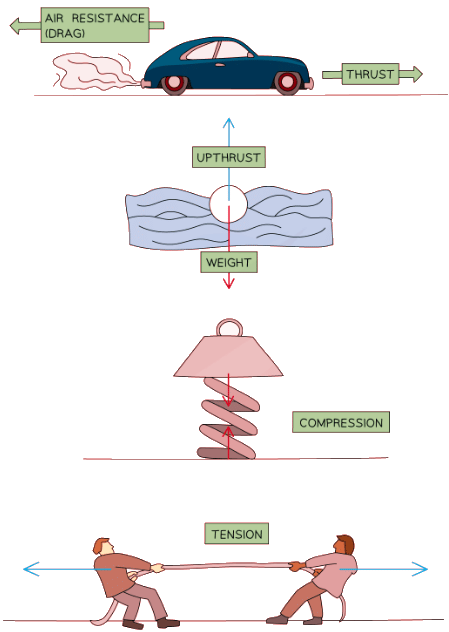Contact & Non-Contact Forces | Physics for Grade 10 PDF Download
| Table of contents |

|
| Introduction |

|
| Contact Forces |

|
| Non-Contact Forces |

|
| Exam Tips |

|
| Solved Example |

|
Introduction
A force is defined as:
- A push or a pull that acts on an object due to the interaction with another object
Forces can have an effect on bodies in several different ways:
- They can change their speed
- They can change their direction
- They can change their shape
Some examples of these changes are:
- An engine can increase the speed of a vehicle due to a force called thrust
- A comet’s direction can be affected by gravitational attraction
- A spring can have its shape changed by the force from a heavy load
 Diagram showing the effects of forces on different objects
Diagram showing the effects of forces on different objects
Important forces to be familiar with:
- Weight – the name given to the force of gravity on a mass
- Electrostatic force – the force between two charged objects
- Thrust – the force causing an object to move (such as the force from a rocket engine)
- Air resistance (or drag) – the friction of the air on a moving object
- Upthrust – the force of a fluid (such as water) pushing an object upwards (making it float)
- Compression – forces that act inward on an object, squeezing it
- Tension – force transmitted through a cable or a string when pulled on by forces acting on its opposite ends
- Reaction force – a force due to contact between two objects
 Diagram showing several different types of forces acting on objects
Diagram showing several different types of forces acting on objects
All forces can be categorised into one of two types:
- Contact forces
- Non-contact forces
Contact Forces
A contact force is defined as:
- A force which acts between objects that are physically touching
Examples of contact forces include:
- Friction
- Air resistance
- Tension
- Reaction force
Friction:
- Is a force that opposes motion
- Occurs when objects rub against each
Air resistance:
- Is a type of friction
- Occurs when an object moves through air
Tension:
- Is a force that pulls two objects connected by a length, such as a string or rope
- Occurs when a force is applied to the length
Reaction force:
- Is a force that pushes touching objects apart
- Occurs when objects are supported by a surface

 Examples of contact forces
Examples of contact forces
Non-Contact Forces
A non-contact force is defined as:
- A force which acts at a distance, without any contact between bodies, due to the action of a field
Examples of non-contact forces include:
- Gravitational force
- Electrostatic force
- Magnetic force
Gravitational attraction:
- The attractive force experienced by two objects with mass
- For example, the force between a planet and a comet
Electrostatic force:
- A force experienced by charged objects which can be attractive or repulsive
- For example, the attraction between a proton and an electron
Magnetic force:
- A force experienced between magnetic poles that can be attractive or repulsive
- For example, the attraction between the North and South poles of magnets
 Examples of non-contact forces
Examples of non-contact forces
Exam Tips
- Getting the terminology correct in this topic is key! When talking about the force of gravity, make sure you refer to it as weight or gravitational attraction. Avoid calling it simply “gravity”, as this term can mean several different things and will likely lose you a mark!
- Avoid using the terms wind resistance (there’s no such thing) or air pressure (something entirely different) when you are talking about air resistance (or drag).
Solved Example
Example:
Ben drags a sledge behind him as he climbs up a hill.
Describe the contact and non-contact forces involved in this scenario.
Step 1: Identify the contact forces
(i) Ben pulls on a rope attached to the sledge producing tension in the rope
(ii) The ground supports Ben and the sledge with a reaction force
(iii) There is friction between the sledge and the ground which opposes the motion
(iv) There is also friction between Ben’s shoes and the ground allowing Ben to climb the hill without slipping down
(v) A very small force due to air resistance slows Ben’s motion up the hillStep 2: Identify the non-contact forces
(i) The gravitational attraction between the Earth and Ben pulls Ben and the sledge downwards
|
124 videos|149 docs|37 tests
|

|
Explore Courses for Grade 10 exam
|

|




















